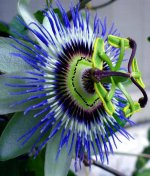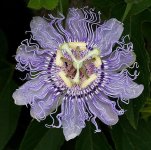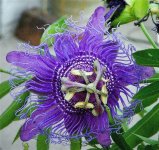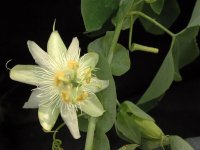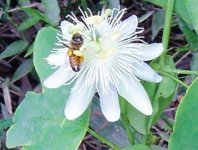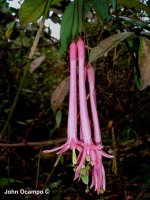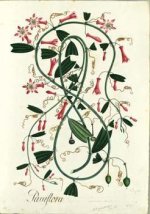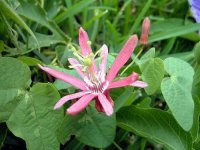-
Members of the previous forum can retrieve their temporary password here, (login and check your PM).
You are using an out of date browser. It may not display this or other websites correctly.
You should upgrade or use an alternative browser.
You should upgrade or use an alternative browser.
Passifloras of Interest..(& MAOI plant Flavonoids)
- Thread starter nen888
- Start date
Migrated topic.
Ambivalent
Rising Star
I am really sorry that i posted so soon before i could compile and write down the details of my extraction..but again i was happy with the results and couldn't wait to tell.
I wanted to add a pictorial which i also prepared and further explains visually all the steps i took in the extraction process, but i am having trouble getting the photos out of my digital camera ( lost my usb cable which has a strange USB standard on the camera side ) which i will solve very soon i promise !!
The yield from around 400-500 g, of green fresh material is around 1 g ( 940 mg) of off-white powder (that is freebase).
This was yielded only from the first initial boil and reduction of the liquid. I didn't exhausted the material with secondary and third boil, so i assume there would be some more (1 acidic boil for 2 h, that was all) !
Further testing of the freebase powder showed that is completely insoluble in acidic ethanol, but easily dissolved in acidic water with very little impurities left behind.
The powder was bio-essayed sublingually ( 30 mg ) and it didn't give any strong noticeable effects by itself (except for the light headedness ) and euphoria (not confirmed, maybe auto suggestion) but it did on the other hand potentiated and prolonged sub breakthrough doses of 15 to 25 mg which with my smoking methods were not so potent.
Another interesting thing is that i haven't had any luck with successfully vaping the freebase or at least with the low doses recommended here for vaping freebase harmala. One thing is that it doesn't melt, burn as easily as others have suggested here for free base harmala.
From all the papers i have read, the main alkaloid of interest in PassiFlora Caerulea is Harmine and negligible amount of harmaline maybe even none.
EDIT : i will be also doing a tincture or ethanol infused extract to check the proposed flavonoids in game as MAOI and i will try to combine both as a full spectrum extract.
will post my further research....any suggestions about testing this compound more accurately is welcomed !!
long live the nexus
I wanted to add a pictorial which i also prepared and further explains visually all the steps i took in the extraction process, but i am having trouble getting the photos out of my digital camera ( lost my usb cable which has a strange USB standard on the camera side ) which i will solve very soon i promise !!
The yield from around 400-500 g, of green fresh material is around 1 g ( 940 mg) of off-white powder (that is freebase).
This was yielded only from the first initial boil and reduction of the liquid. I didn't exhausted the material with secondary and third boil, so i assume there would be some more (1 acidic boil for 2 h, that was all) !
Further testing of the freebase powder showed that is completely insoluble in acidic ethanol, but easily dissolved in acidic water with very little impurities left behind.
The powder was bio-essayed sublingually ( 30 mg ) and it didn't give any strong noticeable effects by itself (except for the light headedness ) and euphoria (not confirmed, maybe auto suggestion) but it did on the other hand potentiated and prolonged sub breakthrough doses of 15 to 25 mg which with my smoking methods were not so potent.
Another interesting thing is that i haven't had any luck with successfully vaping the freebase or at least with the low doses recommended here for vaping freebase harmala. One thing is that it doesn't melt, burn as easily as others have suggested here for free base harmala.
From all the papers i have read, the main alkaloid of interest in PassiFlora Caerulea is Harmine and negligible amount of harmaline maybe even none.
EDIT : i will be also doing a tincture or ethanol infused extract to check the proposed flavonoids in game as MAOI and i will try to combine both as a full spectrum extract.
will post my further research....any suggestions about testing this compound more accurately is welcomed !!
long live the nexus
Awesome thread.
I wonder about the flavonoids, despite having MAOI properties not one report of flavonoids orally activating DMT exists and they occur so widely that if there were active one would expect more data.
The MAOI properties of the harmala alkaloids may not be responsible for some of the major effects. A lot of MAOI property having molecules do not potentiate tryptamines, activate DMT or have pronounced effects like the harmala alkaloids. The effect of the betacarbolines upon glutamate in the brain explain potentiation as that the psychedelic experience is dependent upon the serotonin-glutamate receptor complex and interacting with this complex can promote or decrease psychedelic effects and harmala alkaloids tend to be ligands for both receptors as well as some others like benzo-receptors.
The activity of flavonoids is entirely theoretical and lacking in any clear evidence at this point so far as I can tell. The activity of the harmala alkaloids on the other hand is well evidenced.
If i wanted to look into flavonoids more (i don't) i'd look into onion leaves, they are a potent source of these molecules, often containing over 1% flavonoids. I can't wait for the report where someone orally activates DMT using onion leaves...
I wonder about the flavonoids, despite having MAOI properties not one report of flavonoids orally activating DMT exists and they occur so widely that if there were active one would expect more data.
The MAOI properties of the harmala alkaloids may not be responsible for some of the major effects. A lot of MAOI property having molecules do not potentiate tryptamines, activate DMT or have pronounced effects like the harmala alkaloids. The effect of the betacarbolines upon glutamate in the brain explain potentiation as that the psychedelic experience is dependent upon the serotonin-glutamate receptor complex and interacting with this complex can promote or decrease psychedelic effects and harmala alkaloids tend to be ligands for both receptors as well as some others like benzo-receptors.
The activity of flavonoids is entirely theoretical and lacking in any clear evidence at this point so far as I can tell. The activity of the harmala alkaloids on the other hand is well evidenced.
If i wanted to look into flavonoids more (i don't) i'd look into onion leaves, they are a potent source of these molecules, often containing over 1% flavonoids. I can't wait for the report where someone orally activates DMT using onion leaves...
..virtually all recent studies of the repeatedly confirmed anxiolytic and sedative effects of P. incarnata conclude that the effects are due to the flavonoids..there are not enough harmalas in standard doses to do this..this is not merely theoretical, and neither is the MAOI and benzadiazopine activity of flavonoids..
there are even more references than i provided earlier, in the attached Flavonoids and the CNS paper..
Albert K Lloyd, this is a cutting edge field of research, and with many kinds of flavonoid out there, so whether onions work or not isn't so relevant..
it is usually up to people like on this site and you or me to do bioassays of such things to get data..the majority stick to known formulas..
300-400 grams dry P. incarnata whole extract or tea..this has orally activated tryptamines in several people, and i do not believe enough harmala alkaloid could have been present to do this..
..the anecdotal and ethnobotanic reports of some passifloras are so interesting that, like many plants, i think the scientific and entheogenic community have been a bit asleep in looking into them until recently..hence this thread..
there are even more references than i provided earlier, in the attached Flavonoids and the CNS paper..
Albert K Lloyd, this is a cutting edge field of research, and with many kinds of flavonoid out there, so whether onions work or not isn't so relevant..
it is usually up to people like on this site and you or me to do bioassays of such things to get data..the majority stick to known formulas..
300-400 grams dry P. incarnata whole extract or tea..this has orally activated tryptamines in several people, and i do not believe enough harmala alkaloid could have been present to do this..
..the anecdotal and ethnobotanic reports of some passifloras are so interesting that, like many plants, i think the scientific and entheogenic community have been a bit asleep in looking into them until recently..hence this thread..
nen888 said:..virtually all recent studies of the repeatedly confirmed anxiolytic and sedative effects of P. incarnata conclude that the effects are due to the flavonoids..there are not enough harmalas in standard doses to do this..this is not merely theoretical, and neither is the MAOI and benzadiazopine activity of flavonoids..
A few of those studies found effects for plant extracts, not isolated purified flavonoids. In one study of Chrysin for example when they purified the flavonoid and gave it to mice it lacked effects above control.
I agree it is cutting edge, so it has a lot that still needs to be worked out.
There are not enough harmalas in a standard dose to have anxiolytic effects?
How much is the standard dose and of what species?
A number of reports exist where people use passiflora sp to activate or potentiate DMT and mushrooms. The doses involved suggestested that the harmala alkaloids were responsible and the lack of the desired effect with low doses indicates that the flavonoids might not be capable of having that effect.
Albert K. Lloyd..there's a lot of neuro-chemical evidence in the aforementioned flavonoid refs..
kaempferol and apiginen are of interest in P. incarnata ..i can personally attest to the effects of this plant (as can Snu Voogelbreinder) , there cannot be enough harmine or harmaline in it to cause the level of effects at smaller doses, and there isn't much else of possible pharmacological activity in there, except flavonoids..
..whether or not there are different strains of P. incarnata or seasonal factors remains unknown to me..
ps. i have given detailed dosage amounts for MAO inhibition earlier in thread..it is the amount of sedation created by herbalist doses that has led to the mainstream viewpoint that it is the flavonoids which are responsible for the sedative/relaxant effects..
pps. i should say, to be correct, that the harmalas are not solely responsible for the effects, obviously they play a role...
kaempferol and apiginen are of interest in P. incarnata ..i can personally attest to the effects of this plant (as can Snu Voogelbreinder) , there cannot be enough harmine or harmaline in it to cause the level of effects at smaller doses, and there isn't much else of possible pharmacological activity in there, except flavonoids..
..whether or not there are different strains of P. incarnata or seasonal factors remains unknown to me..
ps. i have given detailed dosage amounts for MAO inhibition earlier in thread..it is the amount of sedation created by herbalist doses that has led to the mainstream viewpoint that it is the flavonoids which are responsible for the sedative/relaxant effects..
pps. i should say, to be correct, that the harmalas are not solely responsible for the effects, obviously they play a role...
..it's also worth noting that flavonoids will stay in the water-soluble fraction of a basic extraction..
the tryptamine potentiating experiments with P. incarnata by Gracie and Zarkov used whole plant water extracts, boiled down and evaporated to a vaporizable 'gunk', which would have contained both flavonoids and harmalas..see Three Beta-Carboline Containing Plants As Potentiators of Synthetic DMT and Other Indole Psychedelics
.
the tryptamine potentiating experiments with P. incarnata by Gracie and Zarkov used whole plant water extracts, boiled down and evaporated to a vaporizable 'gunk', which would have contained both flavonoids and harmalas..see Three Beta-Carboline Containing Plants As Potentiators of Synthetic DMT and Other Indole Psychedelics
.
Ambivalent
Rising Star
Ok guys, for everyone that is interested..here's the process i used for extracting the alkaloids. I have new harvested material, so i wil try to make more detailed extraction and include some photos from more important parts of the process.
Passiflora Caerulea extraction
Passiflora Caerulea extraction
..hey, great Ambivalent..harmine, harmaline, harmol, harmalol and harman are the main P. incarnata alkaloids..
to clarify what i was saying earlier, at 300 grams dried there should be about 300mg harmalas, certainly enough to produce effects incl. MAO inhibition..it's the sedative effects at prescribed herbalist doses in which the flavonoids are believed responsible..
..when enough passionflower was used to orally activate tryptamines the effects were quite noticeably different in character to both P. harmala or B. caapi, due to i believe the flavonoids in conjunction with harmalas..
on the behavioural effects of the flavonoids see: Behavioural effects of Passiflora incarnata L. and its indole alkaloid and flavonoid derivatives and maltol in the mouse.
it turns out there are different chemotypes of incarnata, but it is the difference in flavonoids which was studied, not alkaloids (which may well vary),
see paper attached below, which lists yet more flavonoids (isovitexin etc.) ..both P. caerulea and P. alba have been sold as P. incarnata herb..photo is P. caerulea as pointed out next post..
to clarify what i was saying earlier, at 300 grams dried there should be about 300mg harmalas, certainly enough to produce effects incl. MAO inhibition..it's the sedative effects at prescribed herbalist doses in which the flavonoids are believed responsible..
..when enough passionflower was used to orally activate tryptamines the effects were quite noticeably different in character to both P. harmala or B. caapi, due to i believe the flavonoids in conjunction with harmalas..
on the behavioural effects of the flavonoids see: Behavioural effects of Passiflora incarnata L. and its indole alkaloid and flavonoid derivatives and maltol in the mouse.
it turns out there are different chemotypes of incarnata, but it is the difference in flavonoids which was studied, not alkaloids (which may well vary),
see paper attached below, which lists yet more flavonoids (isovitexin etc.) ..both P. caerulea and P. alba have been sold as P. incarnata herb..photo is P. caerulea as pointed out next post..
Attachments
Ambivalent
Rising Star
hey nen888, i think this photo which you posted last, its from the Blue PassionFlower, not the Incarnata (Purple Passion Flower) which also has its tentacles longer and obviously with Purple color dominating them.
Its interesting to find out how these plants adapt, and how much their profile changes due to the adaptation on different climate.
As i wrote, i was extracting from less than 400 g for sure. The yield was higher than the one you stated, but again I am extracting from Blue Passion flower in December - January ( - 5 to 15 degrees c this winter ) . I don't know if this affects it and how much. Something changes for sure . Iv seen their flowering period is usually shorter. It lasts couple of months. So where are they putting the rest of the energy..
Btw, i havent tested for flavonoids yet and their activity...but will post as soon as i do.
Edit : Btw i agree that the full potency and character of the Passion flower's psychoactivity its owed to the combined action of both alkaloids and flavonoids.
thanks for reply on this subject
Its interesting to find out how these plants adapt, and how much their profile changes due to the adaptation on different climate.
As i wrote, i was extracting from less than 400 g for sure. The yield was higher than the one you stated, but again I am extracting from Blue Passion flower in December - January ( - 5 to 15 degrees c this winter ) . I don't know if this affects it and how much. Something changes for sure . Iv seen their flowering period is usually shorter. It lasts couple of months. So where are they putting the rest of the energy..
Btw, i havent tested for flavonoids yet and their activity...but will post as soon as i do.
Edit : Btw i agree that the full potency and character of the Passion flower's psychoactivity its owed to the combined action of both alkaloids and flavonoids.
thanks for reply on this subject
I've heard reports of activity of very low doses of harmala alkaloids.
They can be curiously active in this way.
Ott for example reports that harmaline potentiated Bufotenine at a dose of 0.11 mg/kg.
I weigh 80kg, so for this type of effect i would require a dose of just under 9mg of harmaline to get this effect, this is far less than would be required to orally activate dmt, but there is a mild sedative/calming effect at these doses.
And while cigarette smokers do not ingest large doses of harmala alkaloids there are studies showing significant effects from the small amounts they do ingest:
h++p://biopsychiatry.com/maoi-smoke.htm
(note that harman is rather potent as an MAOI)
There is some decent evidence that very low doses of harmala alkaloids are fairly psychoactive.
I'd expect 5mg of many harmala alkaloids to be a strong enough dose to achieve mild sedation and mild potentiation.
I've read of a range of concentrations from about 0.1 to 0.5% harmala alkaloids for P. incarnata. I'd expect then that the dose for mild sedative effects ranges from 10-50 grams of material. In terms of extracts i'd expect doses to follow a similar pattern. A 10 X extract would require 1-5 grams of material etc.
They can be curiously active in this way.
Ott for example reports that harmaline potentiated Bufotenine at a dose of 0.11 mg/kg.
I weigh 80kg, so for this type of effect i would require a dose of just under 9mg of harmaline to get this effect, this is far less than would be required to orally activate dmt, but there is a mild sedative/calming effect at these doses.
And while cigarette smokers do not ingest large doses of harmala alkaloids there are studies showing significant effects from the small amounts they do ingest:
h++p://biopsychiatry.com/maoi-smoke.htm
(note that harman is rather potent as an MAOI)
There is some decent evidence that very low doses of harmala alkaloids are fairly psychoactive.
I'd expect 5mg of many harmala alkaloids to be a strong enough dose to achieve mild sedation and mild potentiation.
I've read of a range of concentrations from about 0.1 to 0.5% harmala alkaloids for P. incarnata. I'd expect then that the dose for mild sedative effects ranges from 10-50 grams of material. In terms of extracts i'd expect doses to follow a similar pattern. A 10 X extract would require 1-5 grams of material etc.
..actually i'll concede i think you're probably right Albert K. Lloyd..it's just that the general naturopathic community thinks it's the flavonoids which are responsible..i think it's the combination of harmalas and flavonoids that creates the magic of P. incarnata..and perhaps higher harmol/harmolol levels than other plants..
..Ambivalent, you're right about the blue passionflower photo..there are many cultivars of P. incarnata and hybrids with P. caerulea..they are very closely related..P. incarnata is also crossed with P. cincinnata in horticulture..
below are P. incarnata and P. incarnata x cincinnata..
..Ambivalent, you're right about the blue passionflower photo..there are many cultivars of P. incarnata and hybrids with P. caerulea..they are very closely related..P. incarnata is also crossed with P. cincinnata in horticulture..
below are P. incarnata and P. incarnata x cincinnata..
Attachments
I do appreciate the plant flavonoid info, that paper about them and the CNS is great stuff!
There is no doubt they are contributing something to the pharmacology of numerous foods, herbs and preparations.
There is no doubt they are contributing something to the pharmacology of numerous foods, herbs and preparations.
..thanks Albert, it's also because of the activity of P. coccinea (which appears to have almost no alkaloids from one test), and hard to explain oral activity of a few acacias, that i became interested in flavonoids...
..there does seem to be a bit of evidence of alkaloid variability in P. incarnata..
Hultin [1965] found initially 0.1%, then up to 0.2% harmala alkaloids..he wrote regarding the harmalas:
other studies found 0.03-0.1% harmalas, but this low figure may be due to extraction methodology..[Bennati 1971]
..certainly more work needs to be done following on from Eskil Hultin in maximizing yields from P. incarnata, and examining seasonal/strain factors..
regarding flavonoids..
..other studies (see earlier) found the flavonoids kaempferol and apigenin, so there must be either strain or seasonal variability..
.
Hultin [1965] found initially 0.1%, then up to 0.2% harmala alkaloids..he wrote regarding the harmalas:
..at 0.2% this would equate to 600mg from 300grams dry herb..Gracie and Zarkov [1986] put the content at up to 0.5% harmala alkaloids..The portion of the ethanol extract of Passiflora incarnata which was soluble in dilute phosphoric acid was made slightly basic with sodium hydroxide and then extracted continuously with ether for several days...Only small amounts alkaloids were extracted...(Further continuous extraction with a mixture of methylene chloride and methanol over a period of a week yielded an extract considerably higher in alkaloid content.)
other studies found 0.03-0.1% harmalas, but this low figure may be due to extraction methodology..[Bennati 1971]
..certainly more work needs to be done following on from Eskil Hultin in maximizing yields from P. incarnata, and examining seasonal/strain factors..
regarding flavonoids..
Menghini A, Mancini LA. TLC determination of flavonoid accumulation in clonal populations of Passiflora incarnata L. Pharmacol Res Commun . 1988;20(suppl 5):113-116.; Duke J. CRC Handbook of Medicinal Herbs . Boca Raton, FL: CRC Press; 1985: 347.Flavonoid content (2.5%) includes flavone di-C-glycosides shaftoside, isoshaftoside, isovitexin (found in highest concentration between preflowering and flowering stages in 1 report), iso-orientin, vicenin, lucenin, saponarin, and passiflorine.
..other studies (see earlier) found the flavonoids kaempferol and apigenin, so there must be either strain or seasonal variability..
.
..Passiflora subpeltata is synonymous with P. alba (White Passionflower), native to Brazil, and a weed in much of the warmer parts of the world including Australia and New Zealand..
Neu (1956) found harman in the plant, Hurst (1942) found cyanogenic glycoides..it has successfully been used once to activate dmt via MAO inhibition, however in the experiment reported in Voogelbreinder (2009) effects lingered for a few days..the bioassay subject believes toxic symptoms (including headache) were induced after eating a palm-sugar based desert, and red meat..there are reports of (non-lethal) cattle poisoning..
..the plant needs to be investigated more with caution..it is very common, and has reportedly been occasionally sold as P. incarnata in the herbal industry [Southern Cross Uni. reserach]..
the flowers are completely edible, and taste like sweet snow-peas (had some the other day)
Neu (1956) found harman in the plant, Hurst (1942) found cyanogenic glycoides..it has successfully been used once to activate dmt via MAO inhibition, however in the experiment reported in Voogelbreinder (2009) effects lingered for a few days..the bioassay subject believes toxic symptoms (including headache) were induced after eating a palm-sugar based desert, and red meat..there are reports of (non-lethal) cattle poisoning..
..the plant needs to be investigated more with caution..it is very common, and has reportedly been occasionally sold as P. incarnata in the herbal industry [Southern Cross Uni. reserach]..
the flowers are completely edible, and taste like sweet snow-peas (had some the other day)
Attachments
AlbertKLloyd said:I've heard reports of activity of very low doses of harmala alkaloids.
They can be curiously active in this way.
Ott for example reports that harmaline potentiated Bufotenine at a dose of 0.11 mg/kg.
I weigh 80kg, so for this type of effect i would require a dose of just under 9mg of harmaline to get this effect, this is far less than would be required to orally activate dmt, but there is a mild sedative/calming effect at these doses.
And while cigarette smokers do not ingest large doses of harmala alkaloids there are studies showing significant effects from the small amounts they do ingest:
h++p://biopsychiatry.com/maoi-smoke.htm
(note that harman is rather potent as an MAOI)
There is some decent evidence that very low doses of harmala alkaloids are fairly psychoactive.
I'd expect 5mg of many harmala alkaloids to be a strong enough dose to achieve mild sedation and mild potentiation.
I've read of a range of concentrations from about 0.1 to 0.5% harmala alkaloids for P. incarnata. I'd expect then that the dose for mild sedative effects ranges from 10-50 grams of material. In terms of extracts i'd expect doses to follow a similar pattern. A 10 X extract would require 1-5 grams of material etc.
it is true that low doses of harmalas can be quite active as Ott has stated in the past..the thing to remember here is that Ott likes to snuff things..from what I remember he was snuffing like 5mg of harmalas. In my experience snuffing very small ammounts of harmalas can be quite active..WAY more active than when used orally..the same goes for sublingual and they are even more active when smoked. The experience feels more full and complete though when they are taken orally.
I cant imagine the harmalas being active in the adverage ammount of passionflower most people drink in a tea. Harmalas are not active for me at any noticable level in doses that low..I can imagine the harmalas being much more active in passionflower when the material is smoked or an snuffed though.
I have used bufotenine in the same way with just like 5-10mg harmalas with it and they do potentiate it. Same goes for adding a very small ammount to a DMT snuff.
Even by itself I can feel 10mg snuffed or taken under the tounge..only really when I lay down and go into it or meditate though. It's the alpha waves I think.
this whole thread as well as the acacia's thread needs to be archived somehow or linked in the nexus wiki..this is important information. Thank you nen888 for this.
..^, thanks jamie..regarding your harmala comments, this is the herbal medicine community's view on P. incarnata..
i again noted, recently, that 3 grams P. incarnata dried herb (commercially obtained) as a tea (2 x 20 minutes boiled) produces noticeable anti-depressant/sedative effects for 30mins-1hr..there would only be around 3 milligrams of harmala alkaloid in this..so either Harman is a much more potent alkaloid than other known harmalas, or the flavonoids are probably responsible..harman needs more research, only demonstrated to be a potent MAOI as recently as 2007 [see Raisin extracts as MAOIs]
..i found something quite interesting recently..in TLC work to differentiate P. incarnata from P. edulis and P. caerulea [Brasseur T, Angenot L. The pharmacognosy of the passion flower [in French]. J Pharm Belg . 1984;39:15-22.]
..MAOI Flavonoids (vitexin etc.) have also been found in P. trinervia and P. sanguinolenta.[see http://pubs.acs.org/doi/abs/10.1021/np50028a036]
as their flavonoid profiles are similar to P. incarnata and caerulea, and they were not tested for alkaloids, these two species may well contain harmalas..
below are 2 images of the unusual P. trinervia (Columbia) and P. sanguinolenta (Equador)
i again noted, recently, that 3 grams P. incarnata dried herb (commercially obtained) as a tea (2 x 20 minutes boiled) produces noticeable anti-depressant/sedative effects for 30mins-1hr..there would only be around 3 milligrams of harmala alkaloid in this..so either Harman is a much more potent alkaloid than other known harmalas, or the flavonoids are probably responsible..harman needs more research, only demonstrated to be a potent MAOI as recently as 2007 [see Raisin extracts as MAOIs]
..i found something quite interesting recently..in TLC work to differentiate P. incarnata from P. edulis and P. caerulea [Brasseur T, Angenot L. The pharmacognosy of the passion flower [in French]. J Pharm Belg . 1984;39:15-22.]
[from Passion Flower Uses, Benefits & Dosage - Drugs.com Herbal Database]..this is very interesting..there are a few varieties of P. edulis..Quantitative analysis of different plant parts from P. incarnata and P. edulis indicate that P. edulis leaves have the highest alkaloid content, and that fruit rinds contain approximately 0.25% alkaloids. Seeds and root tissue have the lowest alkaloid content. These findings may have economic importance. P. edulis fruit rinds, by-products of passion fruit juice production, may provide an economical source of alkaloids.
..MAOI Flavonoids (vitexin etc.) have also been found in P. trinervia and P. sanguinolenta.[see http://pubs.acs.org/doi/abs/10.1021/np50028a036]
as their flavonoid profiles are similar to P. incarnata and caerulea, and they were not tested for alkaloids, these two species may well contain harmalas..
below are 2 images of the unusual P. trinervia (Columbia) and P. sanguinolenta (Equador)
Attachments
Similar threads
- Replies
- 0
- Views
- 135
- Replies
- 0
- Views
- 82
- Replies
- 15
- Views
- 2K

